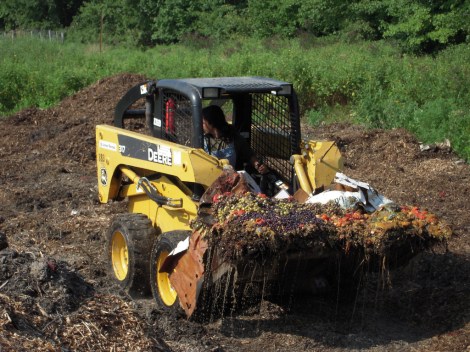Forty percent of the food we grow in the U.S. is wasted somewhere between the farm, the table, and the garbage can. There’s the stuff Americans allow to rot in their fridges (though I know you dear and conscientious readers would never do that), but there’s also tons of food lost on the farm and in the packaging process.
A new study from the Natural Resources Defense Council surveyed crop waste at farms in California’s Central Valley. From NRDC’s Switchboard blog:
Results are by no means conclusive due to the limited data set, but they do offer an anecdotal snapshot of the extent of losses that occur. They found that “shrink,” another word for lost product, could be as low as 1 percent for the crops which were studied and, depending on weather and market conditions of a particular year, as high as 30 percent. Losses for plums and nectarines were on the high side; head lettuce and broccoli losses (at least where the farmer was selling florets separately) were relatively low.
This can translate to a lot of food. If just 5 percent of the U.S. broccoli production is not harvested, over 90 million pounds of broccoli go uneaten. That would be enough to feed every child that participates in the National School Lunch Program over 11 4-ounce servings of broccoli.
It also translates to a lot of resources used for naught. For example, if just 5 percent of broccoli grown in Monterey County, California (producer of 40 percent of U.S. broccoli) is not harvested, that represents the wasted use of 1.6 billion gallons of water and 450,000 pounds of nitrogen fertilizer (a contributor to global warming and water pollution). And let’s not forget about the energy, pesticides, land, and other resources that went into growing that food.
This amount of crop shrinkage is staggering. And to some degree it’s our own damn fault for picking only the prettiest produce at the store — the uglies never even make it to the shelves. The NRDC also points to other factors: overplanting in an attempt to hedge against pests or weather but that can end up costing more than a loss might have; shortages of skilled farm labor; spoilage that prevents farms from donating unsellable stuff; and the horrors of the “spot market” …
… where products are traded for immediate delivery without forward contracts. Prices vary significantly in this market, and growers sometimes face a tough decision just prior to the harvest window. Low spot prices can mean that the costs of harvesting a crop and getting it to market outweigh the revenue from its sale. When this is the case, a grower may decide to leave entire fields of harvest-ready product unharvested. These fields are known as “walk-bys” in the industry, and are particularly prevalent in years of high supply.
Yes, who said capitalism wasn’t moral?
Food waste is hardly an American problem. The European Union is set on reducing its own food waste, which is currently 89 million tons annually. A new project called FUSIONS — Food Use Social Innovations by Optimising Waste Strategies — aims to reduce E.U. food waste by 50 percent by 2025.
In the U.K., government officials are shockingly indignant about food waste. From The Independent:
Owen Paterson, the environment secretary, deplored the amount of food we waste in a speech to the Federation of Women’s Institutes last week.
He singled out the “cult of perfection” that leaves no room in our supermarkets for ugly produce, but also said the following about the Nigellas and Jamies of this world.
“Cookbooks in the 1970s and 1980s always have had chapters on using up scraps and leftovers. But this stopped in the 1990s. That is a little tiny area where you can change culture. Lots of food can be rehashed together and it is perfectly good.”
How can we shift the tide stateside? NRDC points to needed policy and behavior changes (the prettiest apple doesn’t necessarily taste better than the homely one). There’s hope, too, in gleaners, which is a much more dignified term than “freegans.” Maybe that’s because they come from France.





